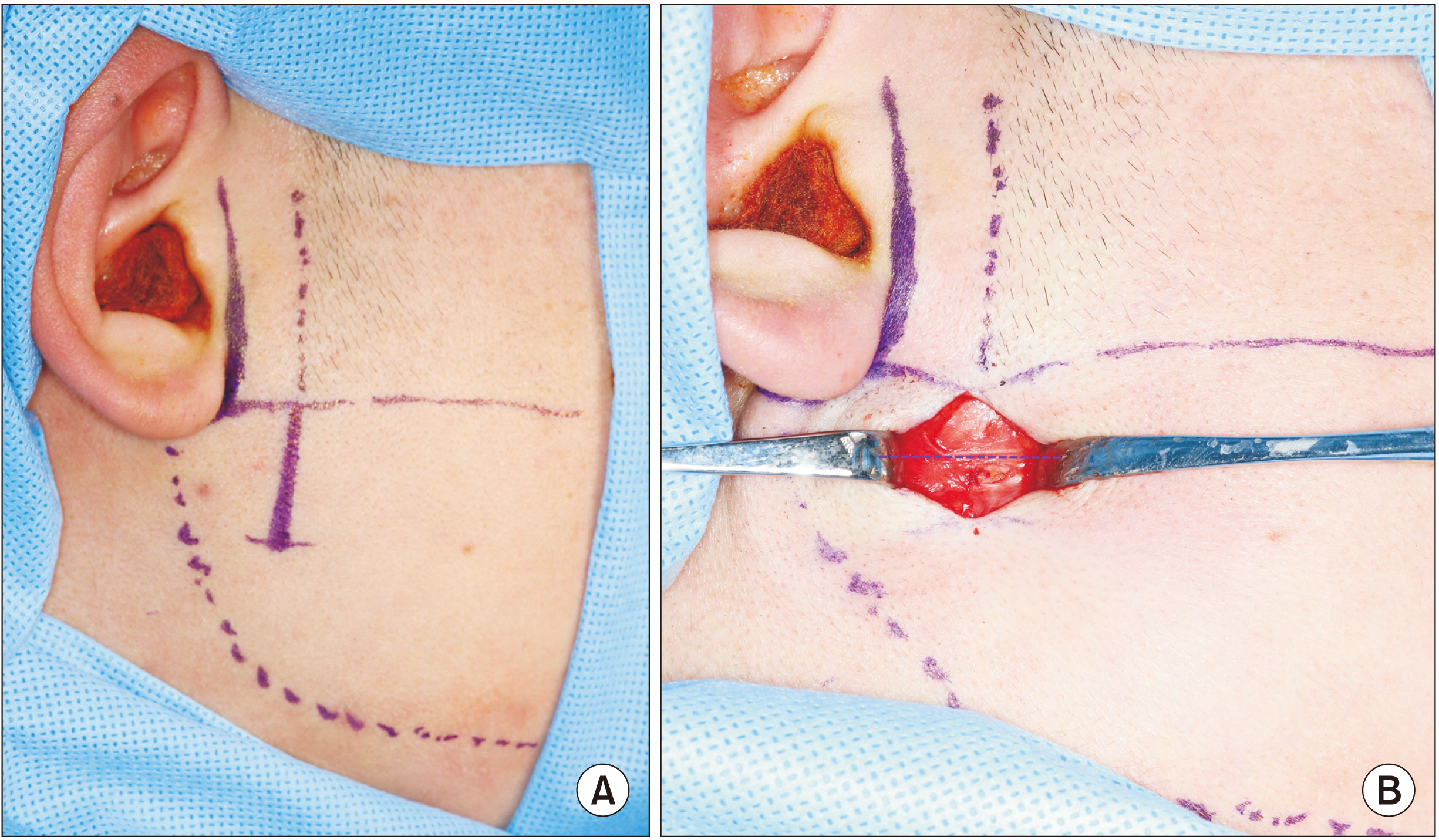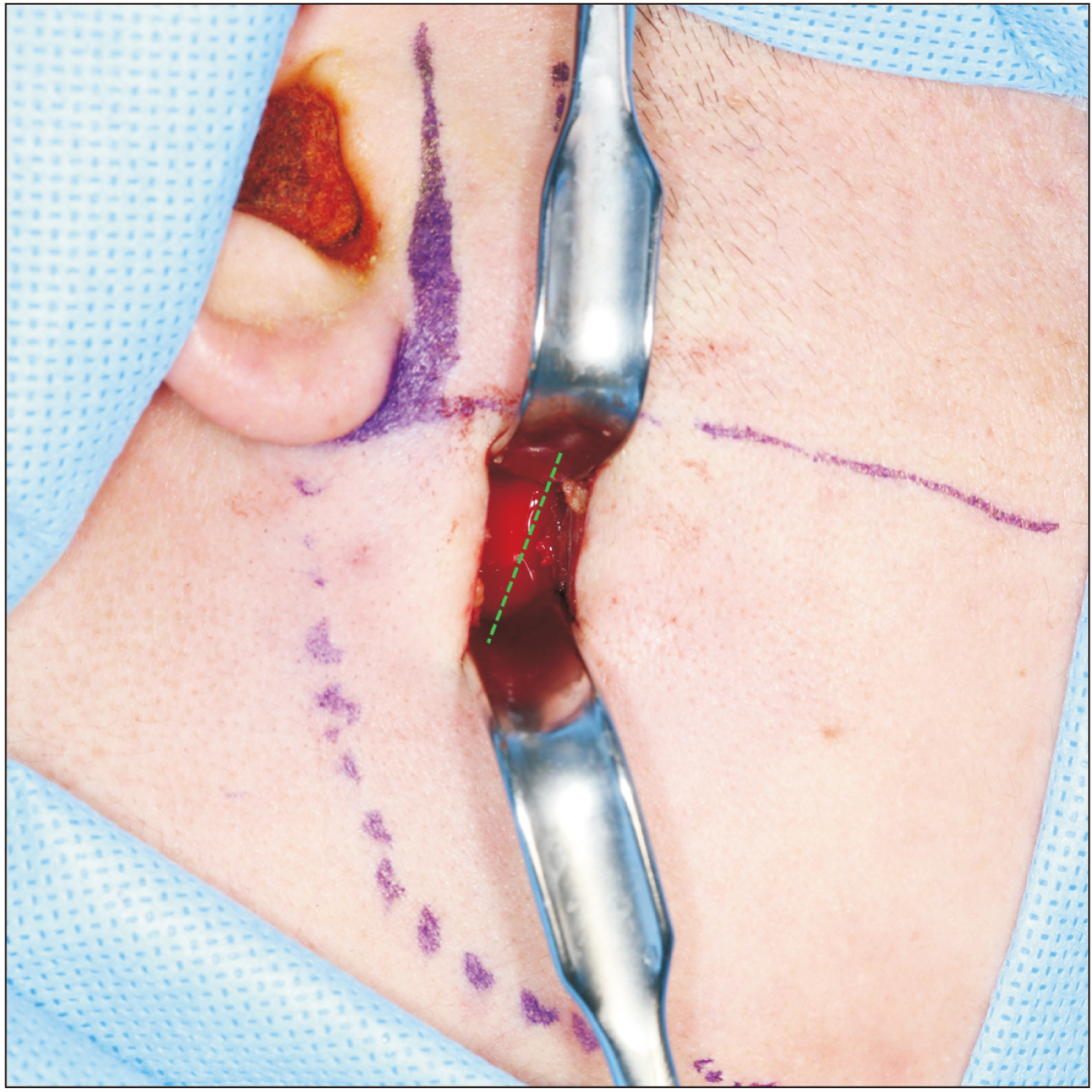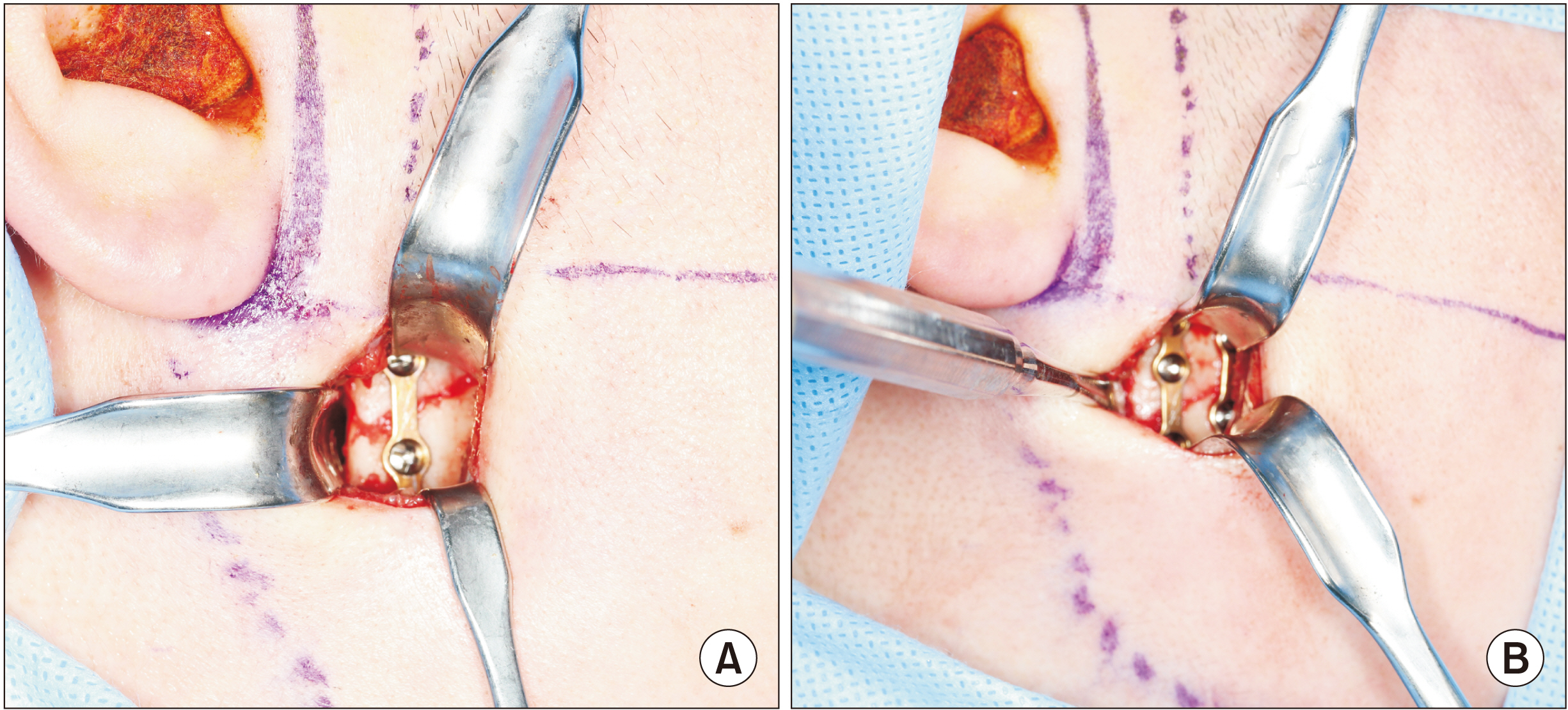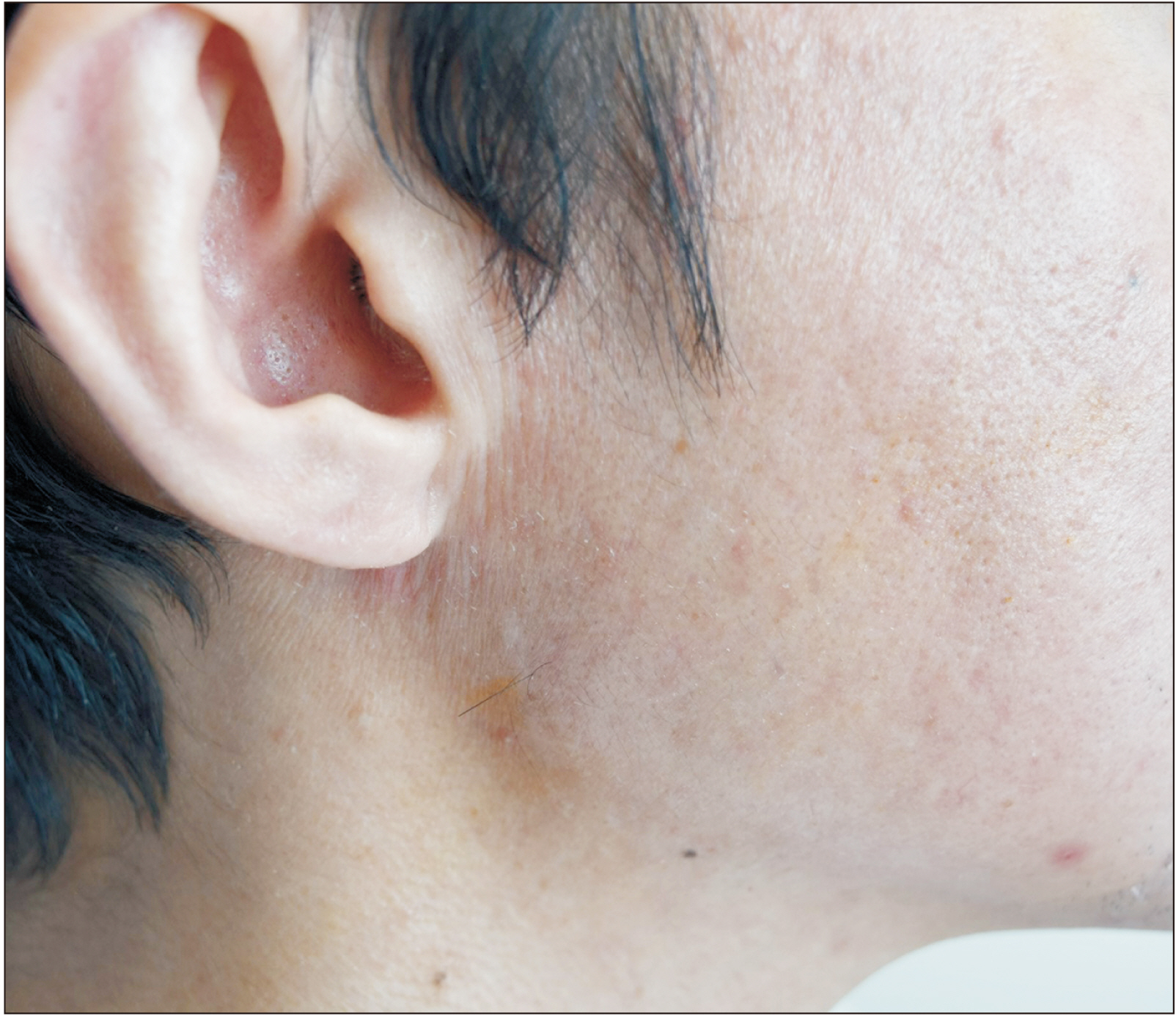J Korean Assoc Oral Maxillofac Surg.
2021 Aug;47(4):327-334. 10.5125/jkaoms.2021.47.4.327.
Direct transparotid approach via a modified mini-preauricular incision for open reduction and internal fixation of subcondylar fractures
- Affiliations
-
- 1Department of Oral and Maxillofacial Surgery, National Health Insurance Service Ilsan Hospital, Goyang, Korea
- KMID: 2519830
- DOI: http://doi.org/10.5125/jkaoms.2021.47.4.327
Abstract
- A transparotid approach, with a retromandibular or preauricular incision, is an alternative surgical approach for treating a subcondylar fracture and reducing the potential for complications such as injury to the facial nerves. However, retromandibular and preauricular incisions are both created far away from the parotid gland–dissection area. Thus, it is necessary to undermine the skin and retract it anteriorly to access the surgical field. Here, we introduce a modified approach wherein the incision allows for direct access to the fracture site. This approach may be adopted to shorten the incision length, reduce the retraction trauma at the surgical site, and help prevent injury to the facial nerve.
Figure
Reference
-
References
1. Rashid A, Eyeson J, Haider D, van Gijn D, Fan K. 2013; Incidence and patterns of mandibular fractures during a 5-year period in a London teaching hospital. Br J Oral Maxillofac Surg. 51:794–8. https://doi.org/10.1016/j.bjoms.2013.04.007 . DOI: 10.1016/j.bjoms.2013.04.007. PMID: 23735734.
Article2. Kang DH. 2012; Surgical management of a mandible subcondylar fracture. Arch Plast Surg. 39:284–90. https://doi.org/10.5999/aps.2012.39.4.284 . DOI: 10.5999/aps.2012.39.4.284. PMID: 22872829. PMCID: PMC3408271.
Article3. Haug RH, Assael LA. 2001; Outcomes of open versus closed treatment of mandibular subcondylar fractures. J Oral Maxillofac Surg. 59:370–5. discussion 375–6. https://doi.org/10.1053/joms.2001.21868 . DOI: 10.1016/j.joms.2010.01.001. PMID: 20363548.
Article4. Worsaae N, Thorn JJ. 1994; Surgical versus nonsurgical treatment of unilateral dislocated low subcondylar fractures: a clinical study of 52 cases. J Oral Maxillofac Surg. 52:353–60. discussion 360–1. https://doi.org/10.1016/0278-2391(94)90436-7 . DOI: 10.1016/0278-2391(94)90436-7. PMID: 8133366.
Article5. Kang SH, Choi EJ, Kim HW, Kim HJ, Cha IH, Nam W. 2012; Complications in endoscopic-assisted open reduction and internal fixation of mandibular condyle fractures. Oral Surg Oral Med Oral Pathol Oral Radiol. 113:201–6. https://doi.org/10.1016/j.tripleo.2011.02.005 . DOI: 10.1016/j.tripleo.2011.02.005. PMID: 22677737.
Article6. Nam SM, Lee JH, Kim JH. 2013; The application of the Risdon approach for mandibular condyle fractures. BMC Surg. 13:25. https://doi.org/10.1186/1471-2482-13-25 . DOI: 10.1186/1471-2482-13-25. PMID: 23829537. PMCID: PMC3708819.
Article7. Van Hevele J, Nout E. 2018; Complications of the retromandibular transparotid approach for low condylar neck and subcondylar fractures: a retrospective study. J Korean Assoc Oral Maxillofac Surg. 44:73–8. https://doi.org/10.5125/jkaoms.2018.44.2.73 . DOI: 10.5125/jkaoms.2018.44.2.73. PMID: 29732312. PMCID: PMC5932275.
Article8. Kanno T, Sukegawa S, Tatsumi H, Karino M, Nariai Y, Nakatani E, et al. 2016; Does a retromandibular transparotid approach for the open treatment of condylar fractures result in facial nerve injury? J Oral Maxillofac Surg. 74:2019–32. https://doi.org/10.1016/j.joms.2016.05.022 . DOI: 10.1016/j.joms.2016.05.022. PMID: 27318190.
Article9. Bhutia O, Kumar L, Jose A, Roychoudhury A, Trikha A. 2014; Evaluation of facial nerve following open reduction and internal fixation of subcondylar fracture through retromandibular transparotid approach. Br J Oral Maxillofac Surg. 52:236–40. https://doi.org/10.1016/j.bjoms.2013.12.002 . DOI: 10.1016/j.bjoms.2013.12.002. PMID: 24370443.
Article10. Liao HT, Wang PF, Chen CT. 2015; Experience with the transparotid approach via a mini-preauricular incision for surgical management of condylar neck fractures. J Craniomaxillofac Surg. 43:1595–601. https://doi.org/10.1016/j.jcms.2015.07.023 . DOI: 10.1016/j.jcms.2015.07.023. PMID: 26286253.
Article11. Shi D, Patil PM, Gupta R. 2015; Facial nerve injuries associated with the retromandibular transparotid approach for reduction and fixation of mandibular condyle fractures. J Craniomaxillofac Surg. 43:402–7. https://doi.org/10.1016/j.jcms.2014.12.009 . DOI: 10.1016/j.jcms.2014.12.009. PMID: 25600628.
Article12. Knepil GJ, Kanatas AN, Loukota RJ. 2011; Classification of surgical approaches to the mandibular condyle. Br J Oral Maxillofac Surg. 49:664–5. https://doi.org/10.1016/j.bjoms.2011.02.009 . DOI: 10.1016/j.bjoms.2011.02.009. PMID: 21453998.
Article13. Ruiz R, Schlund M, Raoul G, Kyheng M, Fontaine C, Nicot R. 2018; Mandibular subcondylar fracture accessibility with transparotid approach by rhytidectomy and modified Risdon approach: an anatomical comparative study. J Craniomaxillofac Surg. 46:2256–60. https://doi.org/10.1016/j.jcms.2018.10.011 . DOI: 10.1016/j.jcms.2018.10.011. PMID: 30420152.
Article14. Saylam C, Ucerler H, Orhan M, Ozek C. 2006; Anatomic landmarks of the buccal branches of the facial nerve. Surg Radiol Anat. 28:462–7. https://doi.org/10.1007/s00276-006-0127-7 . DOI: 10.1007/s00276-006-0127-7. PMID: 16838086.
Article15. Tang W, Gao C, Long J, Lin Y, Wang H, Liu L, et al. 2009; Application of modified retromandibular approach indirectly from the anterior edge of the parotid gland in the surgical treatment of condylar fracture. J Oral Maxillofac Surg. 67:552–8. https://doi.org/10.1016/j.joms.2008.06.066 . DOI: 10.1016/j.joms.2008.06.066. PMID: 19231779.
Article16. Liu P, Li F, Peng L. 2021; An anatomical landmark for retromandibular transparotid approach to treat subcondylar fractures. J Craniofac Surg. 32:e427–9. https://doi.org/10.1097/SCS.0000000000007233 . DOI: 10.1097/SCS.0000000000007233. PMID: 33201073.
Article17. Yabe T, Tsuda T, Hirose S, Ozawa T. 2013; Preauricular transparotid approach to mandibular condylar fractures without dissecting facial nerves. J Craniofac Surg. 24:1365–7. https://doi.org/10.1097/SCS.0b013e318285d9a3 . DOI: 10.1097/SCS.0b013e318285d9a3. PMID: 23851809.
Article18. Draaijers LJ, Tempelman FR, Botman YA, Tuinebreijer WE, Middelkoop E, Kreis RW, et al. 2004; The patient and observer scar assessment scale: a reliable and feasible tool for scar evaluation. Plast Reconstr Surg. 113:1960–5. discussion 1966–7. https://doi.org/10.1097/01.prs.0000122207.28773.56 . DOI: 10.1097/01.prs.0000122207.28773.56. PMID: 15253184.
Article19. Kudur MH, Pai SB, Sripathi H, Prabhu S. 2009; Sutures and suturing techniques in skin closure. Indian J Dermatol Venereol Leprol. 75:425–34. https://doi.org/10.4103/0378-6323.53155 . DOI: 10.4103/0378-6323.53155. PMID: 19584482.
Article
- Full Text Links
- Actions
-
Cited
- CITED
-
- Close
- Share
- Similar articles
-
- Case Report of Transparotid Approach of Mandibular Subcondylar Fracture
- Transmasseteric Approach for Open Reduction and Internal Fixation of Mandible Subcondylar Fracture
- Complications of the retromandibular transparotid approach for low condylar neck and subcondylar fractures: a retrospective study
- The Endoscopic Repair of Mandibular Subcondylar Fracture through Intraoral Approach
- Modified high-submandibular appraoch for open reduction and internal fixation of condylar fracture: case series report











